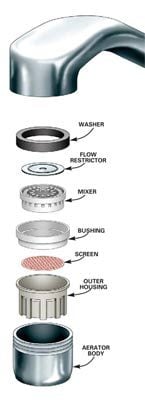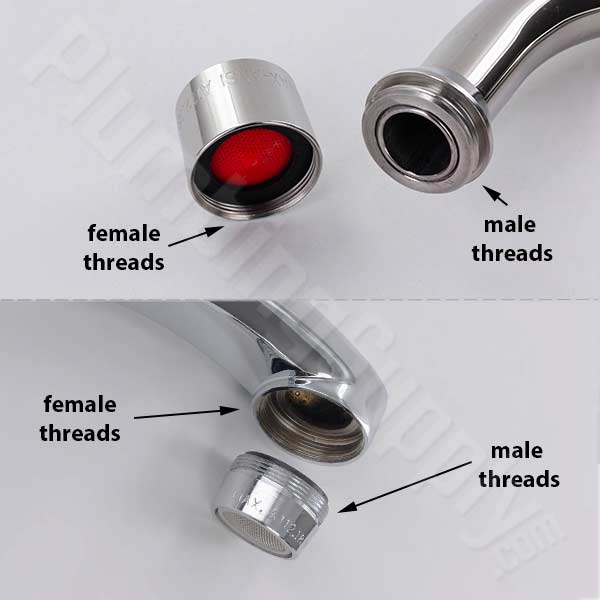Clean water is sent to your home under constant pressure to ensure it makes its way throughout the community ending at your tap which normally contains a faucet aerator that performs a few different important functions that you never realized. What does a faucet aerator do?
Aerators:
- Add air to H2O for the feeling of high pressure
- Control the stream from the faucet
- Act as a filter to catch sand & debris that accumulates in H2O lines
- Prevent splashing
- Shape the H2O stream coming out of the faucet
- Prevents noise
- Conserve the amount of overall H2O usage
- Reduce energy consumption
A Faucet aerator is normally a simple, mesh screen made of metal or plastic that is attached to the end of a faucet with some sort of housing. As water flows through this screen it is divided into many small streams with air in between. This little guy has a big job lowering water consumption, and utility bills and over the long term saving the environment.
What is a Faucet Aerator
Faucet aerators are screens that screw into the kitchen and bathroom faucets that contain holes in the screens which add air to the water as it streams out of the faucet. Besides adding air to the water and leaving the faucet their job more importantly these aerators:
- Reduce the amount of water that comes out of a faucet and control the stream.
- They can catch particles that can make it through your supplier’s service lines. A faucet aerator screen can act as a filter and catch sand and debris that is produced over time or after your water supplier performs hydrant flushing during the course of the year.
- Prevent splashing
- Shape the water stream coming out of the faucet spout, to produce a straight and evenly pressured stream regulating the flow
- Prevent noise
- Saving water then equates to energy cost reduction
The Environmental Protection Agency (EPA) has developed a program that identifies a water-efficient product that has been independently certified to meet EPA WaterSense criteria for efficiency and performance.
The EPA says that certain recommended faucets and aerators can meet their criteria to reduce the demand for water. A little job like switching from an aerator that releases 2.2 gallons per minute to one that releases 1.5 gallons per minute can reduce water use by 30% without reducing performance. 
The organization will certifiy the product identified by the label if it meets the criteria. These products include faucets and faucet aerators that can meet these specifications that the government agency determines will cut costs of water consumption over periods of time, reduceing the demands on households. Achieving these savings can be as easy as twisting on a WaterSense labeled aerator, which can cost as little as a few dollars. When buying one look for this label!
How to Remove Faucet Aerator

Some Delta faucets come with recessed aerators, which are hidden and can’t be removed using a wrench. If you don’t have the specific Delta key, you might be able to get a universal key from a hardware store or get a good bite using your fingers it’s most likely it’s only hand tight anyway. If that is not possible use a pair of needle-nose pliers to remove the hidden piece.
Moen faucet aerators have ridges built into them so you can turn them. If you can’t unscrew the piece with your fingers, you might be able to get a better grip with your fingernails or use a butter knife or flathead screwdriver. To remove-Turn the aerator counterclockwise.
On a standard Aerator, try to turn by hand- if it won’t budge then use pliers to turn the outside of the housing protecting the piece with a washcloth. (the rubber washer will normally stick up in the faucet’s opening so you may have to dig it out) Some aerators have male threads others have female threads.
- If your faucet has threads on the outside, it is male threaded – which means you need to buy a FEMALE threaded aerator to fit over it.

- If your faucet has threads on the inside, it is female threaded and you’ll need a MALE threaded aerator
Look for the EPA Water Sense logo or seal on the packaging these products offer equivalent or superior performance while helping you protect the environment and potentially save on utility bills. Look for the WaterSense label on our water-efficient products.
Many aerators aren’t very difficult to remove and are normally hand tightened. Recessed models can be a little more tricky than exterior models because there’s no way to remove them with a wrench or pliers.
If you can’t make it budge then use a hairdryer just run the hot air on the tip of the faucet aerator to warm it up-then turn it counterclockwise. When all else fails call a plumber if you can’t remove it but there is no reason to think you can’t it’s a simple chore.
Cleaning Faucet Aerator
Water pressure has decreased in your faucet, the aerator may be the problem. An aerator can get clogged with silt and debris, or with the buildup of minerals from the water. No problem it’s a quick and easy fix. To clean the aerator, simply unscrew and remove the mesh. It might just need rinsing and scrubbing off with a small brush, like an old toothbrush. Mineral buildup can be removed by soaking the aerator in a 50/50 solution of water and vinegar for several hours or using a mild descaler, such as Lime-Away.
Once you decide to take off the faucet aerator to clean it:
- Protect the aerator if you are using pump pliers by separating with a washcloth or a piece of pliable material
- Keep the order of the parts you take off so you can put the aerator back in the same way
- Use an old toothbrush to clean the screen inside
- Rinse both sides of the screen
- If there are noticeable calcium deposits(hard water) on the aerator then soak in a 50/50 solution of water and vinegar for several hours or using a mild descaler, such as Lime-Away
- Rinse
- Reassemble
JimGalloway Author/Editor

References: EPA Bathroom Faucets
Tap-The Big Benefit of Updating Faucets
